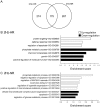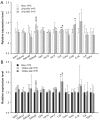Differences in neural-immune gene expression response in rat spinal dorsal horn correlates with variations in electroacupuncture analgesia
- PMID: 22879942
- PMCID: PMC3411776
- DOI: 10.1371/journal.pone.0042331
Differences in neural-immune gene expression response in rat spinal dorsal horn correlates with variations in electroacupuncture analgesia
Abstract
Background: Electroacupuncture (EA) has been widely used to alleviate diverse pains. Accumulated clinical experiences and experimental observations indicated that significant differences exist in sensitivity to EA analgesia for individuals of patients and model animals. However, the molecular mechanism accounting for this difference remains obscure.
Methodology/principal findings: We classified model male rats into high-responder (HR; TFL changes >150) and non-responder (NR; TFL changes ≤ 0) groups based on changes of their pain threshold detected by tail-flick latency (TFL) before and after 2 Hz or 100 Hz EA treatment. Gene expression analysis of spinal dorsal horn (DH) revealed divergent expression in HR and NR after 2 Hz/100 Hz EA. The expression of the neurotransmitter system related genes was significantly highly regulated in the HR animals while the proinflammation cytokines related genes were up-regulated more significantly in NR than that in HR after 2 Hz and 100 Hz EA stimulation, especially in the case of 2 Hz stimulation.
Conclusions/significance: Our results suggested that differential regulation and coordination of neural-immune related genes might play an important role for individual variations in analgesic effects responding to EA in DH. It also provided new candidate genes related to EA responsiveness for future investigation.
Conflict of interest statement
Figures









References
-
- NIH Consensus Conference. Acupuncture. JAMA 280: 1518–1524. - PubMed
-
- Ulett GA, Han S, Han JS (1998) Electroacupuncture: mechanisms and clinical application. Biol Psychiatry 44: 129–138. - PubMed
-
- Han JS (2011) Acupuncture analgesia: areas of consensus and controversy. Pain 152: S41–48. - PubMed
-
- Zhao ZQ (2008) Neural mechanism underlying acupuncture analgesia. Prog Neurobiol 85: 355–375. - PubMed
-
- Sun J, Qin W, Dong M, Yuan K, Liu J, et al. (2010) Evaluation of group homogeneity during acupuncture stimulation in fMRI studies. J Magn Reson Imaging 32: 298–305. - PubMed
Publication types
MeSH terms
Substances
LinkOut - more resources
Full Text Sources
Medical

